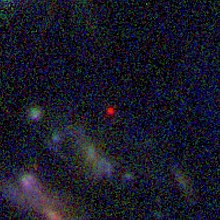| GLASS-z12 | |
|---|---|
 Close-up view of GLASS-z12 from the James Webb Space Telescope Close-up view of GLASS-z12 from the James Webb Space Telescope | |
| Observation data (J2000 epoch) | |
| Constellation | Sculptor |
| Right ascension | 00 13 59.76 |
| Declination | −30° 19′ 29.1″ |
| Redshift | 12.117±0.012 (spectroscopic) 12.4+0.1 −0.3 12.42+0.27 −0.14 12.28+0.08 −0.07 |
| Distance |
|
| Apparent magnitude (V) | 27.0 AB (F200W) |
| Characteristics | |
| Mass | ≈1.0×10 M☉ |
| Size | ~3000 ly (1 kpc) |
| Half-light radius (physical) | 500 pc |
| Other designations | |
| GHZ2 · GLASS-17487 | |
| References: | |
GLASS-z12 (formerly known as GLASS-z13) is a Lyman-break galaxy discovered by the Grism Lens-Amplified Survey from Space (GLASS) observing program using the James Webb Space Telescope's NIRCam in July 2022. Spectroscopic observations of GLASS-z12 by the Atacama Large Millimeter Array (ALMA) in August 2022 confirmed that the galaxy has a spectroscopic redshift of 12.117±0.012, making it one of the earliest and most distant galaxies ever discovered, dating back to just 350 million years after the Big Bang, 13.6 billion years ago. ALMA observations detected an emission line associated with doubly ionized oxygen (O III) at 258.7 GHz with a significance of 5σ, suggesting that there is very low dust content in GLASS-z12, if not the early universe as well. Also based on oxygen-related measurements, the age of the galaxy is confirmed.
GLASS-z12 derives its name from the GLASS survey that discovered it and its estimated photometric redshift of approximately z = 12.4+0.1
−0.3. GLASS-z12 was initially announced as GLASS-z13 because it was thought to have a higher redshift of z = 13.1. This redshift value was later revised down to z = 12.4 in October 2022, resulting in the renaming of this galaxy.
GLASS-z12 has a light-travel distance (lookback time) of 13.6 billion years. However, due to the expansion of the universe, its present proper distance is 33.2 billion light-years. It was discovered alongside another galaxy, GLASS-z10, comparable to GN-z11, also one of the oldest galaxies discovered.

See also
- CEERS-93316
- Earliest galaxies
- HD1 (galaxy)
- JADES-GS-z13-0
- List of the most distant astronomical objects
References
- ^ Naidu, Rohan P.; et al. (November 2022). "Two Remarkably Luminous Galaxy Candidates at z ≈ 10 − 12 Revealed by JWST". The Astrophysical Journal Letters. 940 (1): 11. arXiv:2207.09434. Bibcode:2022ApJ...940L..14N. doi:10.3847/2041-8213/ac9b22. S2CID 250644267. L14.
- ^ Bakx, Tom J. L. C.; et al. (2023). "Deep ALMA redshift search of a z ~ 12 GLASS-JWST galaxy candidate". Monthly Notices of the Royal Astronomical Society. 519 (4): 5076–5085. arXiv:2208.13642. doi:10.1093/mnras/stac3723.
- ^ Donnan, C. T.; et al. (November 2022). "The evolution of the galaxy UV luminosity function at redshifts z ≃ 8 - 15 from deep JWST and ground-based near-infrared imaging". Monthly Notices of the Royal Astronomical Society. 518 (4): 6011–6040. arXiv:2207.12356. Bibcode:2023MNRAS.518.6011D. doi:10.1093/mnras/stac3472.
- Harikane, Yuichi; et al. (2023). "A Comprehensive Study of Galaxies at z ~ 9–16 Found in the Early JWST Data: Ultraviolet Luminosity Functions and Cosmic Star Formation History at the Pre-reionization Epoch". The Astrophysical Journal Supplement Series. 265 (1): 5. arXiv:2208.01612. Bibcode:2023ApJS..265....5H. doi:10.3847/1538-4365/acaaa9. S2CID 251253150.
- ^ Wright, Edward L. (2022). "Ned Wright's Javascript Cosmology Calculator". University of California, Los Angeles. Retrieved 24 November 2022. (H0=67.4 and OmegaM=0.315 (see Table/Planck2018 at "Lambda-CDM model#Parameters" )
- Castellano, Marco; et al. (July 2022). "Early Results from GLASS-JWST. III. Galaxy Candidates at z ~9–15". The Astrophysical Journal Letters. 938 (2): L15. arXiv:2207.09436. Bibcode:2022ApJ...938L..15C. doi:10.3847/2041-8213/ac94d0. S2CID 250644263.
- ^ Koren, Marina (22 July 2022). "The Webb Space Telescope Is a Time Machine Observed". The Atlantic. Retrieved 22 July 2022.
- O'Callaghan, Jonathan (20 July 2022). "JWST has found the oldest galaxy we have ever seen in the universe - Discoveries from the James Webb Space Telescope are pouring in, with an analysis of the latest data revealing a galaxy that dates back to just 300 million years after the big bang – the oldest we have ever seen". New Scientist. Retrieved 12 February 2023.
- O'Callaghan, Jonathan (14 September 2022). "JWST's First Glimpses of Early Galaxies Could Break Cosmology - The James Webb Space Telescope's first images of the distant universe shocked astronomers. Is the discovery of unimaginably distant galaxies a mirage, or a revolution?". Scientific American. Retrieved 16 September 2022.
- ^ Adkins, Jamie (17 November 2022). "NASA's Webb Draws Back Curtain on Universe's Early Galaxies". NASA. Retrieved 23 November 2022.
- Staff (25 January 2023). "Astronomers confirm age of most distant galaxy using oxygen". Phys.org. Retrieved 26 January 2023.
- Bakx, Tom J.L.C.; et al. (23 December 2022). "Deep ALMA redshift search of a z ~ 12 GLASS-JWST galaxy candidate". Monthly Notices of the Royal Astronomical Society. 519 (4): 5076–5085. arXiv:2208.13642. doi:10.1093/mnras/stac3723. Retrieved 26 January 2023.
| James Webb Space Telescope | ||
|---|---|---|
| Instruments and sensors |   | |
| Elements | ||
| Stages |
| |
| Images |
| |
| Discoveries |
| |
| Institutions | ||
| Related |
| |
| 2022 in space | ||
|---|---|---|
| Space probe launches |
|   |
| Impact events | ||
| Selected NEOs | ||
| Discoveries | ||
| Comets | ||
| Space exploration | ||